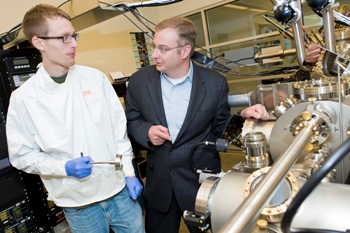A Purdue University research team has succeeded in developing ultra-pure material capable of capturing novel states of matter and finding applications in superior-speed quantum computing.
 Purdue graduate student John Watson and Michael Manfra, Associate Professor of Physics, work with the high-mobility gallium-arsenide molecular beam epitaxy system
Purdue graduate student John Watson and Michael Manfra, Associate Professor of Physics, work with the high-mobility gallium-arsenide molecular beam epitaxy system
A material called gallium arsenide was utilized for observation of states wherein the electrons were no longer subject to single-particle Physics laws, but was controlled by their interactions with each other.
Manfra, a Physics professor, with his team constructed a device known as high-mobility gallium-arsenide molecular beam epitaxy system or MBE. This equipment is placed at Purdue's Birck Nanotechnology Center. It produces ultra-pure semiconductor materials having accuracy at the atomic-layer. The semiconductor material is a perfectly arranged lattice of arsenic and gallium atoms to enable capturing of electrons on a two dimensional plane, avoiding the movement of electrons upwards and downwards and restricting their mobility to side-to-side and front-to-back.
In order to obtain favorable conditions to attain the correlated state, it is necessary to cool the electrons to very low temperatures and apply magnetic field over the electrons. An assistant professor of Physics department, Gabor Csathy cooled the electrons and material to 5 mK close to 460 degrees or absolute zero with the help of a special equipment. According to him, the electrons perform a complicated dance to arrange themselves in the best way to reach the lowest energy level, thereby creating new ground states or patterns.
Csathy, specializing in semiconductors’ quantum transport is capable of obtaining complex electrons' mobility measurements. The standard measurement for determining quality of a semiconductor is electron mobility with unit centimeters squared per volt-second (cm2/Vs). The research team has recently obtained a measurement of electron mobility of about 22 million cm2/Vs.